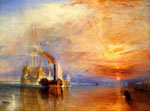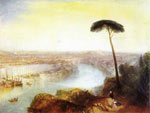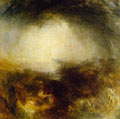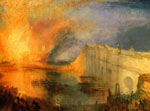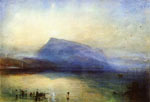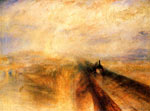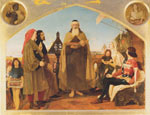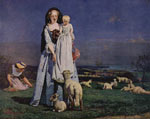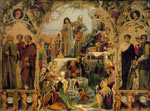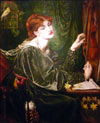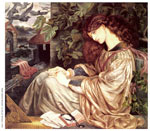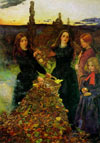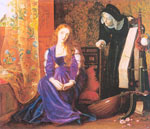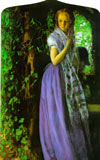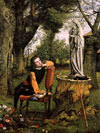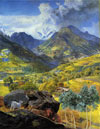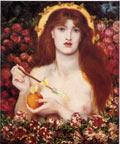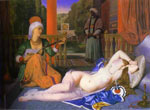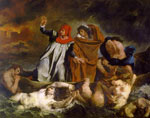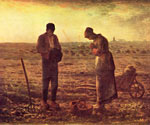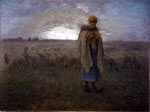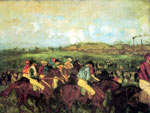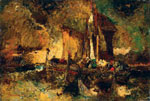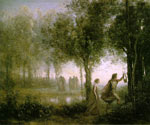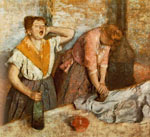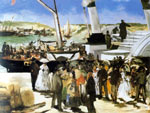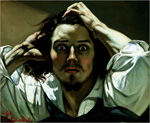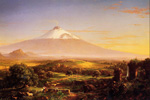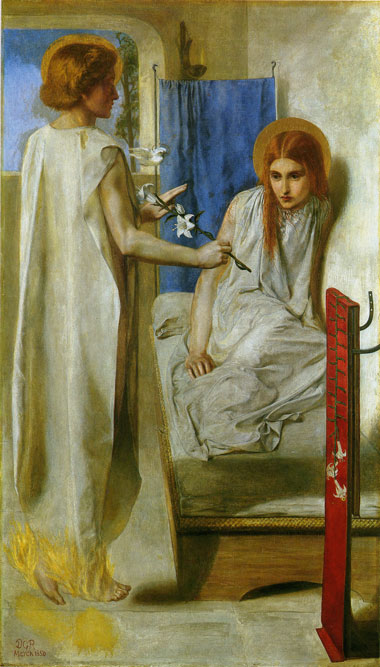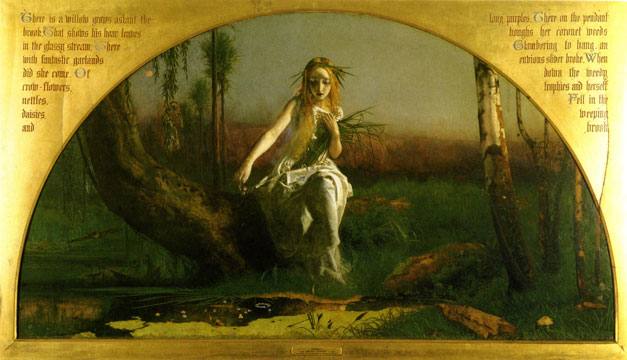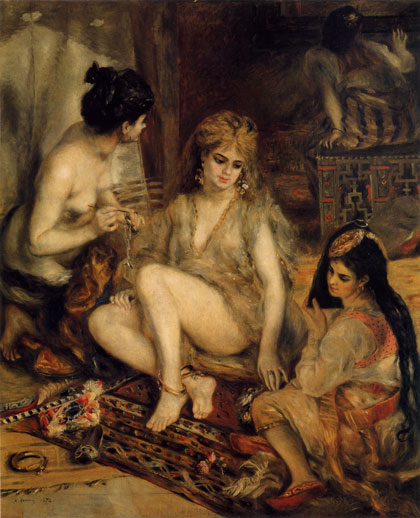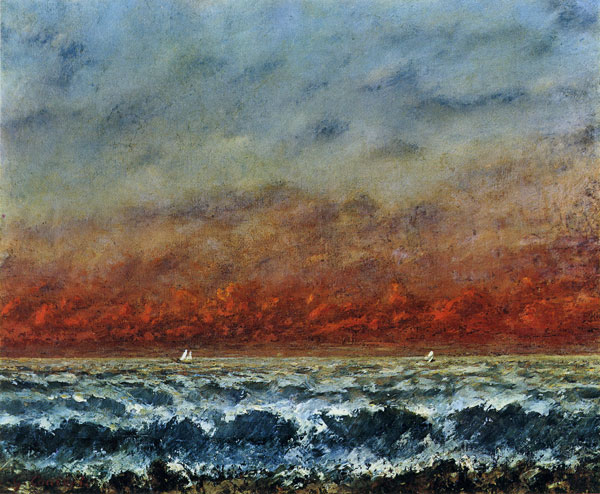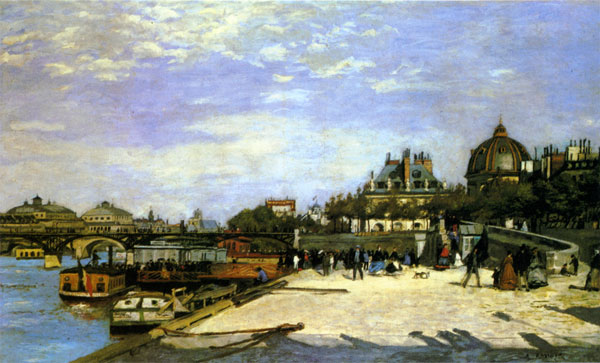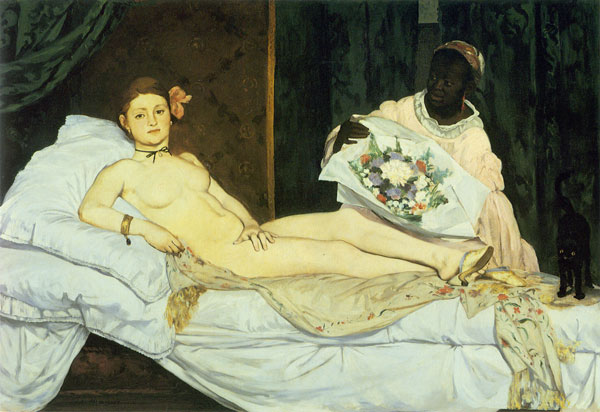
Moving Movements, History of Modern Painting, 1840 - 70
ENGLISH AND FRENCH REVOLUTIONS IN THE ART OF PAINTING, 1840 - 1870
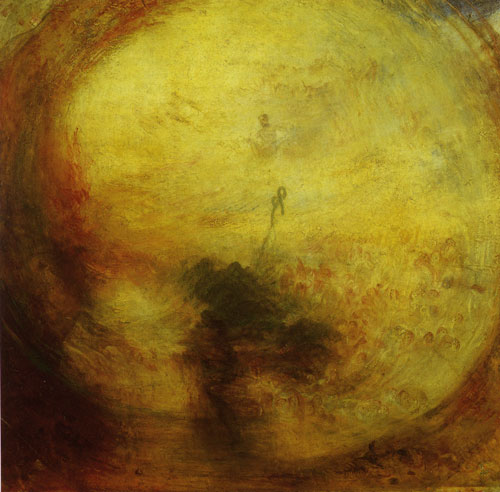
J.M.W. Turner, Light and Colour, Goethe's Theory, Morning after the flood, 1843
English pioneers
Turners "Yacht approaching the Shore" from 1838 - 1840, is far from his other precisely painted landscapes. It is very close to an abstract work, a vision in air and water, with only the little sails as recognisable shapes. Very well known is his "Steam Train over the Bridge" from
1844. In 1845 he paints "festivals" in oil. From his vague, indefinable colour play several shapes occur, as unreal shades,
barely recognisable on the foreground, in the distance nothing but lines. By means of colour and light, the vague and fine lines, an atmosphere of happiness radiates, and also of commotion, a real festive mood.
The rare has something unreal and is far from resembling the later impressionists.
In the years 40 also apocalyptic, religious visions arise, with monsters or angels, rapid shades in a game of colour and light.
Turner
chose suited subjects for this game: lakes, rivers, sea, air, storms... His technique of covering, transparent layers, with little figuration or contours, will not be practised by other artists for a long time, we recognise it with certain contemporary artists, as
Mochel, Velly, Gerbier and Le Marechal.
click the thumbnails
William J. M. Turner
The fighting Temeraire
tugged to her last Berth
to be broken up
William J. M. Turner
Rome from mount Aventine
William J. M. Turner
Shade and Darkness
The evening of the Deluge 1843
William J. M. Turner
The Burning of the Hause
of Lords and commons 1835
William J. M. Turner
The Blue Rigi Lake of Lucerne Sunrise
William J. M. Turner
Rain Steam and Speed
the Great Western Railway
William J. M. Turner
Venetian Festival 1845
William J. M. Turner
Study Of A Castle By A Lake
Ford Madox Brown
John Wycliffe reading his translation
of the bible to John of Gaunt
Ford Madox Brown
Ford Madox Brown
Poetry
Dante Gabriel
Rossetti
Veronica Veronese
Dante Gabriel
Rossetti
Pia Tolomei
Everett Millais
Autumn Leaves
Arthur Hughes
The Pained Heart
Arthur Hughes
April Love 1856
William Dyce
Titians First Essay in Colour
John Brett
Val d'Aosta 1858
Dante Gabriel Rosetti
Venus Verticordia
Ingres
Odalisque and Slave
Delacroix
The Barque of Dante 1882
Jean-François Millet
Angelus
Jean-François Millet
Shepherdess
Degas
Course de Gentlemen
Monticelli
Before The Storm
Corot
Orpheus
Degas
Repasseuses
Edouard Manet
Folkestone
Gustave Courbet
The desparate Man
(self-portrait),
1843-45
Thomas Cole
Mount Aetna from Taormina, 1842
Dante Gabriël Rossetti, ecce anulla domini, 1850 |
Ford Maddox Brown painted in this neo-gothic style, and also made the suitable frames with gothic vaults and a lot of gold leaves, as in "English Poetry" from
1845 - 51. Also Dante Gabriel Rossetti painted in a certain resemblance with the earlier gothic, with the same symbols, but with realistic scenes and brilliant colours. As for example "The Annunciation": poetical colours, perfect lilies, realistic body postures. Rossetti made a real fire in his studio for painting the fire under the feet of the angel. The academic art didn't paint the reality, but rather a kind of supposed reality. The painting was made conforming to how people looked at things, or as people wanted certain things should look like: the legs had to be shorter then in reality, the feet of the women smaller, all the leaves intact and without being shrivelled. That is why Rossetti burned a fire: to paint as it really was, not as was expected from a fire on a canvas. Often contemporary critics blame the academic painters of that time for not seeing that a horse in gallop does not touch the ground at a certain moment. But people were not blind in those days. The truth is: when a painter in that time should have painted a galloping horse off the ground, the admirers would never accept such a representation. The public would have found it totally unnatural. They wanted to see a painted image according to the usual expectations. |
Everett Millais painted in 1849 "Isabella": middle age figures and interior, very realistic persons, accurate, full of light and rich of colour. Even bolder is his work "Autumn Leaves" from 1856, which looks very expressionistic, as a result of the light effects and the mood emanating from the colours.
Arthur Hughes, Ophelia, 1852 |
Holman Hunt painted in 1850 "Valentine": a brilliant silver armour, a delicious flower field, wonderful violet cloths, even the autumn in the wood shines. In 1856 Arthur Hughes painted "Ophelia": wonderful light, sharp in the front, with a blur background, only using ochres and greens. The painting is assimilated in a frame with a half circle opening, in gold and with gothic letters. In other works Hughes also used a lot of brilliant colours. |
William Dyce painted in 1856 - 57 "Titian": painstaking precise, lively colours, a lot of nature, a very realistic and spontaneously posture and facial expression. The flowers on the foreground look like painted by the earlier gothic painters. "The Stone Breaker" (1857 - 58) of John Brett is very precise and radiates light, but the chosen colours are unnatural which gives the work a fairylike impression. Nevertheless this canvas is a social indict.
This examples show us how a movement started, and how this painters worked different then before, even different between them and between their works.
Rossetti, Hunt and Millais started calling themselves the Pre-Raphaelites. They wanted the canvas be shining with colours and light again, wanted to paint to nature and where not afraid of sensual postures. To be precise, materials where bought or lent, sometimes they did put their canvas in nature, a well was dug to be able to paint the plants better... The themes came from literature (Shakespeare, Poe...), nature or social life.
A lot of painters joined the group later, or worked together with them, but some of them quickly gave up as a result of the indifference of the public: Deverell, Collinson, Collins, Dyce, Burton, Wallis, Egley,
Bowler, Halliday, Martineau, Scott, Redgrave, Paten, Windus, Wade, Sandys,
Holiday, Solomon, Stillman, Grimmshaw, Rooke,...
For the brilliant colours they did search for old techniques. They placed several colours beside each other, as the later Monet and Renoir will do, but in smaller strokes, and covered them with glaze. The sheep fleeces of Hunt for example
are not just white, they are full of colours, making together a kind of lively ivory white.
The impressionists will not cover the strokes.
In 1864 - 68 Rossetti painted his "Venus" en started a series of ladies in symbolist style and in oil. In '60 a younger friend of him started, Burne-Jones, with gouache paintings. The countenance of his work was often spiritual.
Pierre-Auguste Renoir, Parijse vrouw in Algerijns Kleed, 1872 |
France 1840 - 1867 C.L.N. Bonaparte was chosen in 1848 as president of the republic, but declared himself to be emperor. The industry was developing in acceleration. It became a trend for the
bourgeoisie, to have one's own collection of art.
Paris regarded itself as being the centre of European art and to prove this, a large exposition came, under the auspices of the
Academie de Beaux-Arts, with 5180 works of art of 1900 painters, several sculptures an other things. The great rivals were Ingres and Delacroix. Corot and
Millet were present but restricted. Courbet was not allowed and built his own pavilion beside. In that time the theme always had to be noble or moralising, with scenes from the bible, history or the classics, later on also landscapes and interiors were allowed. Monet and Renoir were refused, Manet was refused because of painting "trivial persons". A wrong assumption often printed in books of art, is that the rising photography would have pushed away realism in art. The true is the exact opposite. Before the camera came, the art was idealistic, not realistic, as mentioned before. |
Realism as a movement was a French revolution in the art of painting. Although the name they did not reproduce as in photography. The term refers to a totally different reaction on idealism: the acceptation of the existence of misery, suffering, death and ugliness as a realistic part of existence. The subjects where "banal", the colours ashen. The poor people were painted instead of the supposed important people, their labour instead of battles, weddings and inaugurations. Nature in general came in the place of the hunting scenes, or the still life with the booty of the hunts, or the vases with flowers. The persons had natural postures, not artificial or forced ones. Human being and nature were mortal: instead of an ideal face came a skin full of wrinkles of old age, plants became shrivelled.
Gustave Courbet, Paysage Maritime, 1874 |
The landscapes of Corot were varying between mythology, romanticism and realism.
The realist Millet painted in 1859 - 60 his famous "Angelus",
of which one can see an awful amount of reproductions nowadays, even on dishes. Several social and political painters arose, often in gloomy sand colours. They revolt against the artificial, the glorified, against snobbery. Also Pissarro was a painter of realism in those days. Courbet was the first to paint outdoors in nature.
His landscapes stayed precise, except sometimes the background. His
School of Barbison is often prescribed as a forerunner of impressionism, but that's an exaggeration, they didn't paint very revolutionary. The first artist to paint in the direction of the later impressionists is Degas, by his "fast" way of working, as well by his subjects, for example "Course de Gentlemen" from 1862. His style was colourful, but more in thin transparent layers then explicit strokes. |
Pissarro did paint in explicit strokes, but used ashy colours. In those times Renoir
painted in a confronting dirty realism, in coarse strokes, as well as Manet. Cézanne painted already in coarse strokes in 1866. Also Boudin did work quite loose, but in greyish or ashy colours. Even Monet was a gloomy realist then.
Strange enough the first pioneers were found in a different direction. Daumier made his "Laundry woman" in 1863, a work that could be put amidst the future expressionists. Gustave Moreau was a renewer,
with some resemblances to Turner. He painted mainly mythological scenes, in a precise style, but in a dream world with brilliant colours.
Beside his large paintings he made a lot of small works, often with figures in thin lines on top of the oil, with the background as a vague abstraction. Who resembled most to the coming impressionists, was Monticelli, when regarded his style. For example his "Don Quixote et Sancho Panza", from
1865: a faint landscape in wild strokes with indefinable silhouettes, in pleasant bright colours, but from a restricted palette.
France between 1867 and 1870
Different reactions where abiding in Europe to the conventionality of academism
with romanticism and neoclassicism. The Pre-Raphaelites and friends still painted, but where revolting by their use of brilliant colours, sensual postures and totally different subjects. At the other hand the French realists did use gloomy colours, but the subjects where social life and the mortal nature. In France painters arose, working not so precise, in more swift strokes, of which the contours stayed clearly visible on the canvas. But only from 1867 they gradually did switch to more lively colours.
Nevertheless "impressionism" is a very artificial name for this group of painters, of which some knew each other and kept contact, and others did not. This impressionists where painting in a quite different way.
Manet and Monet, for example, where painting very different.
There where several impulses to this new way of working. We already pointed out the liberation from the fixed way of living in the 18th and early 19th century, beside the appealing sketches or studies from the acknowledged "masters". But oddly also the element water contributed to the new painting styles.
First in technique: the aquarelle was the first to be acquainted with loose brush strokes, with witch the colours became more intense. The method of short strokes also prevents unwanted structures in the water colours, such as edges, spots, flows... Also spontaneity is very important in watercolour lines, the first contact of brush and paper can be very decisive, because unwanted spots cannot be hidden under covering new layers. A sublime example is the "tête de lion"
(around '43) by Delacroix. This technique was transformed to an oil technique by the impressionists.
But also as a subject water had great influence: the steam boats and steam trains came up, a boat trip became a wanted diversion for the bourgeoisie. The sea was now much more painted, as well as rivers, lakes, waterfalls. In the former academic style those waters didn't go very well, a new technique was needed. So it is obvious that the first paintings painted in more rough strokes were sea sights, as we can for example see with works of Courbet. His sea views had a clear "impressionistic" character.
This develloppement of traffic, but also of the industry in general, created an ever faster society, and that also inspired to paint faster. In addition, new techniques in oil colours contributed to more brilliant colours. Prussian blue and Naples yellow were existing from respectively 1704 and 1740. In 1802 cobalt blue came on the market, viridian green in 1818 and
ultramarine in 1826. Cadmium red and yellow were from 1829 on the market, cerulean blue
and cobalt violet in 1859. The strong and long lasting cobalt and cadmium colours where due to the upcoming chemical industries.
Pierre-Auguste Renoir, le Pont des Arts, Paris, 1867 |
Probably the French painters had seen the Pre-Raphaelites, a trip to England had become much easier thanks to the steam boats. In 1870 - 71, during the war with Germany, Monet and Pissarro had fled to London. Renoir painted in 1867 his "Pont des Arts", in "rough stroke style", with transparent spots in several mixed colours. Guillaumin already painted in large strokes in 1869, but kept fine contours. Because he was of a better off family, similar to Manet, he was able to follow the Beaux-Arts and learned from Ingres and others. While he was copying old masters, he already painted other subjects, not classical at all, such as cigarette smoke, trains, steam boats... |
While the annual "salons" where under the dictatorship of the academic, the modernizing painters started their own "Salon de refuger", which where eagerly visited by the public, more to laugh with it then to admire. Cézanne, Fantin-Lateur, Guillaumin, Jongkind, Pissarro, Whistler, Manet held their expositions there. Renoir and Morisot joined them in 1864, Monet and Degas in 1865, Bazille and Sisley in 1866, Gonzales in 1870. Cézanne was often refused even at those saloons.
Eduard Manet, Olympia, 1863 |
Manet was sometimes present in the classical, academic salons, because for example he had painted a Spanish danseuse, which took the fancy because the wife of the emperor was Spanish. At the world exposition of 1867 the censorship was enormous. Manet and Courbet constructed their own pavillion, the other renewers couldn't afford that. Interesting is the official critique on Manet's "Olympia": the naked body was too pale, the look too realistic, and coldly estimating, there was a black woman on the canvas (the servant) and what's more... a black cat! |
![]()
The term "impressionism" does not come from the artists. An art critics opinion was that those artists did not paint the real, but their impression of reality, and from this the name impressionism was derived. A doubtful remark, because everyone who tries to paint the reality, can only paint his or her own impression. The way reality was interpreted, always differs from one painter to another. If impressionists do not represent a part of the reality, they do it to be able to represent better other facets of this very same reality, as for example the vibration of the light. A painting on canvas (or on paper) has its limitations, it will not really radiate light, it is not three dimensional, it does not move. But these three aspects can be suggested with different methods. For example for the light: mixing different kind of strokes, adding dark shadows. Shadows can also bring depth, also certain colours can, because some colours put themselves in the front, while others, like deep blue, seem to jump to the background. Certain postures of persons, vague or painted running out, can suggest movement. Even the future abstract painters loved to play with the suggestion of depth and movement.
In impressionism the precise was consecrated to the game of light, and the increase of depth and movement. This is visible in different modern works, such as the studies of Delacroix, for example his "tête
de lion", the horses of Degas, and in the outdoor paintings of Renoir and Monet.
Copyright for the text of all pages of this History of Modern Painting: Johan Framhout; text written in 1990-92; revisionned and put on the internet in 2005; translation in English 2012

